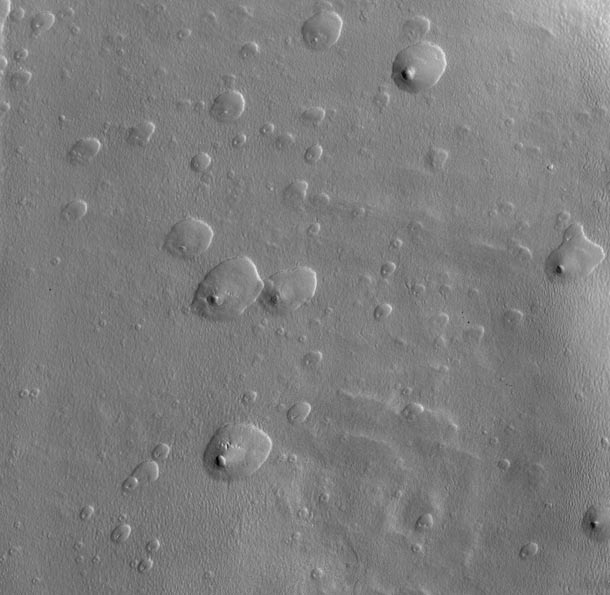Mars craters are sublime

Someday, Mars will stop surprising me.
Today is not that day.
The image below was taken by the HiRISE camera on the Mars Reconnaissance Orbiter, which has been taking devastatingly high-res pictures of the Red Planet for many years. While passing over the edge of the Tharsis Shield -- a huge uplifted region of Mars home to its four gigantic volcanoes --it saw this bizarre fieldof craters:
[Click to hephaestenate.]
First, you may think these are mounds and not craters, but that's an illusion. Our brain uses illumination to gauge up and down in pictures like these, and assumes the sunlight is coming from above. However, these really are craters, but the illumination is coming from below -- north is roughly toward the top of the picture and the crater field is at a northern latitude of about 50°. Flip the picture over if it helps (I'll be honest, even doing that makes it hard for me to see these as other than mounds; confounded brain!). You can see more examples of this illusion here, here, and here.
But that's not the weirdest thing about these craters. What's really odd is they aren't circular! Impacts are generally round unless 1) the impact is at a very shallow angle, b) the terrain suddenly goes from one kind of material to another, creating a discontinuity, or γ) something happened after the crater was formed to distort it.
A shallow-angle impact is almost certainly not the case here, since there are so many craters spread out over the region that an incoming object would've had to break up into a gazillion pieces, all of which came in at that angle. Not impossible, but it seems unlikely.
The changing terrain idea doesn't work, since again the craters are spread out over the area. You might see one crater with a sudden break in its rim or change in shape, but dozens? Spread out in all directions? Nope.
That leaves after effects, and in this case we have two more clues. One is that all the craters have their long axes aligned; in other words they all point in the same direction. The other is that every crater has roughly the same features: a small crater in the lower left hand side, and the shallow floor reaching up and to the right. Another clue? The illumination angle again: the Sun is shining so that it illuminates the upper right side of the crater wall.
Why is that last part important? Because sunlight on Mars turns ice into water vapor.
Here's the idea. At this latitude on Mars, water ice has been seen just below the surface. In fact, one way it's seen is when small meteorite impacts carve out craters, exposing it. These craters are all small (the biggest one in this shot is about 75 meters across), and judging from their appearances are all about the same age. That implies they're secondary craters, caused when ejected debris from an impact rains back down to the surface.
These secondary impacts plopped down all over this terrain, blasting through the top layer of the Martian surface and exposing the ice underneath. The Sun then started to melt the ice (or more properly sublimate it; with the very thin atmosphere there ice goes directly from a solid to a gas), and as it did so the terrain around it collapsed a bit. The Sun shines from the south to the north, so the northern rims of the craters receive the most heat, and expand in that direction.
Then, some time later, what you have left are small circular craters - the original impacts - off to one side of an elongated crater that extends in a northward direction, and that extended part has a flat bottom due to the disappearing layer of ice that used to be there.
Tadaaa! Now, this is just an idea and may not turn out to be correct (note: this isn't my idea either; I'm paraphrasing and expanding on the description on the HiRISE site). But it does neatly explain everything we see in this picture.
I'm fascinated by geology, whether it's here on Earth or on other worlds. Like astronomy, events leave lasting evidence, and sometimes when you look at a landscape -- or a galaxy or a nebula or a star -- you see the clues from many events that happened after one another, and it's not always easy to disentangle them.
It's a puzzle, but you know what? Puzzles are fun. Getting to the answer is where the joy is, and then having the answer is where satisfaction lies. And once you have that, why look over there! Another puzzle! Yay!
Science is a Universe full of never-ending puzzles, and I don't know a single scientist who would have it any other way.
Image credit: NASA/JPL/University of Arizona





























